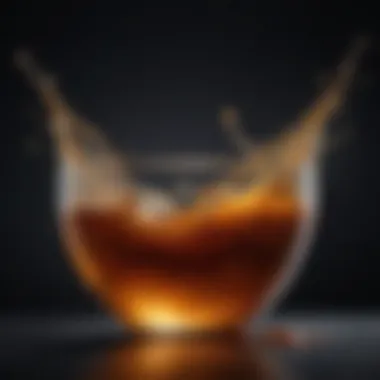Top Leave-In Treatments for Bleached Hair Care


Intro
Bleached hair requires specialized care due to its delicate nature. The process of bleaching strips hair of its natural pigments and oils, leaving it vulnerable to damage and breakage. This is where leave-in treatments come into play. These products are designed to penetrate the hair shaft, providing hydration and protection that is essential for maintaining the health of bleached hair.
Understanding the specific needs of bleached hair is crucial for anyone looking to enhance their hair care routine. Leave-in treatments can restore moisture, reduce frizz, and protect against environmental stressors. They are often infused with nourishing ingredients like oils, proteins, and vitamins that can help to repair damage and promote shine.
Throughout this article, we will explore the best leave-in treatments tailored for bleached hair. We will cover key aspects including product benefits, application techniques, and what to look for in ingredients. By the end, readers will be well-equipped to select the most suitable leave-in treatment that meets their hair's specific needs.
Understanding Bleached Hair
Bleached hair requires a specific care approach due to its altered structure. Understanding this aspect is crucial for anyone looking to maintain hair health after undergoing the bleaching process. When hair is bleached, it loses its natural pigments and can become weaker and more fragile. This knowledge sets the foundation for why leave-in treatments become essential.
The Process of Hair Bleaching
Bleaching hair involves a chemical process that lightens the hair’s color. The treatment often uses hydrogen peroxide or other bleaching agents to strip away the natural pigments found in hair. This process penetrates the hair shaft and breaks down the melanin, the pigment responsible for hair color. The outcome can vary widely based on the hair's original color, texture, and condition before treatment. As a result, after bleaching, hair often requires additional care to maintain its look and health.
Common Issues Faced by Bleached Hair
Dryness
Dryness is one of the most prevalent issues that arise in bleached hair. Chemically treated hair tends to lose moisture quickly, leading to brittleness. This characteristic of dryness means that those with bleached hair face a higher risk of damage from environmental factors, such as sun exposure and wind. The intricate balance of moisture must be restored to avoid further complications. Products rich in moisture can help mitigate these effects.
Breakage
Breakage occurs when the weakened hair structure cannot withstand daily stressors. After bleaching, the internal bonds broken during the process can increase the risk of hair snapping or splitting. This presents a significant challenge, as broken strands can lead to uneven hair and hinder styling efforts. The importance of using leave-in treatments becomes evident here; they not only hydrate but also give strength back to fragile strands.
Loss of Shine
Loss of shine is another common concern. Bleached hair tends to appear duller and lacks the luster of unprocessed hair. This is due to the cuticle layer being damaged during bleaching, which can impact how light reflects off the strands. A product that includes beneficial ingredients can restore some of that lost sheen. Ensuring that hair maintains its vibrancy is crucial for those seeking to enhance their appearance post-treatment.
Why Leave-In Treatments Matter
Leave-in treatments play a vital role in maintaining the integrity of bleached hair. These products provide essential hydration and protection after washing. They help to seal the hair cuticle, keeping moisture locked in, and they often contain nutrients that restore elasticity and strength. Incorporating leave-in treatments into a hair care routine allows for continuous support for hair that has undergone bleaching, addressing specific needs with targeted ingredients. By understanding the challenges that come with bleached hair, one can make informed choices about necessary treatments.
Key Ingredients in Leave-In Treatments
When it comes to caring for bleached hair, the key ingredients in leave-in treatments can make a significant difference. These components are crucial in restoring moisture, repairing damage, and enhancing the overall vitality of bleached locks. Understanding what these ingredients do can help in selecting the right treatment for your specific needs. They address the common issues faced by bleached hair, such as dryness and breakage, while also providing protection against external elements.
Hydrating Agents
Glycerin
Glycerin is a humectant that draws moisture from the environment into the hair. This characteristic makes it particularly powerful for maintaining hydration levels in bleached hair. It is often included in leave-in formulas due to its ability to soften and smooth hair.
One of the key advantages of glycerin is its lightweight nature. It does not weigh hair down, making it suitable for fine or thin hair types. However, in very humid conditions, glycerin’s moisture-attracting properties can lead to frizz if not balanced with the right occlusive agents. Therefore, while it is beneficial, one should pay attention to weather conditions when using products with glycerin.
Aloe Vera
Aloe vera is renowned for its soothing and moisturizing properties. It contains vitamins, minerals, and amino acids, all vital for hair health. In the context of bleached hair, aloe vera helps soothe the scalp and provides significant hydration. Its gel-like consistency allows for easy application and absorption into the hair shaft.


The unique feature of aloe vera is its ability to not only moisturize but also promote hair growth and health. Regular use can improve the overall texture and manageability of hair over time. However, individuals with sensitive scalps should always do a patch test before use, as some may experience irritation.
Proteins
Keratin
Keratin is a fibrous protein that is a crucial component of hair structure. As bleached hair can often lose its natural keratin due to the chemical process, adding this protein back through leave-in treatments can significantly help restore its strength. Keratin treatments can also enhance the hair's natural shine and smoothness.
One of the main benefits of keratin is its ability to fill in damaged areas of the hair shaft, making it look fuller and healthier. However, it's essential to choose products carefully, as excessive protein can lead to hair feeling stiff or brittle. Balancing protein with moisture is critical for the best results in hair care routines.
Silk Protein
Silk protein, derived from silkworms, provides a luxurious component to hair products. It helps in moisture retention while also forming a protective barrier around the hair, making it ideal for bleached hair. Silk protein enhances the overall appearance by adding shine and softness without making the hair heavy.
The key characteristic of silk protein is its small molecular weight, enabling deep penetration into the hair shaft. As a result, it can provide lasting effects, but some users may find it harder to rinse out completely. This could cause product buildup if not washed out properly, so attention is needed regarding frequency of use.
Oils
Argan Oil
Argan oil is a powerhouse of nutrients, known for its moisturizing and nourishing qualities. Rich in fatty acids and vitamin E, it helps restore the natural lipid barrier that bleached hair often lacks. Consequently, it not only hydrates the hair but also protects it from further damage.
Another appealing aspect of argan oil is its versatility. It can be used on all hair types, providing nourishment without weighing them down. However, individuals should keep in mind that excessive use can cause greasiness, so a small amount is usually sufficient to reap its benefits.
Coconut Oil
Coconut oil is widely recognized for its deep conditioning properties. It penetrates the hair shaft more effectively than many other oils, resulting in better moisture retention and reduced protein loss. It also helps combat frizz, leaving hair looking smoother and more manageable.
The standout characteristic of coconut oil is its ability to protect hair from damage during styling. It can be a perfect choice for those who use heat styling tools regularly. However, for some, it can feel heavy, so users with fine hair should apply it sparingly to avoid weighing hair down.
Understanding these key ingredients not only helps in selecting effective leave-in treatments but also empowers users to tailor their hair care regimens according to the specific needs of their bleached hair.
Top Leave-In Treatments for Bleached Hair
Choosing the right leave-in treatment for bleached hair is crucial. Bleached hair tends to be more damaged, making it essential to select products that provide extra care. Leave-in treatments offer hydration, repair, and protection, addressing the specific needs of bleached hair. They allow for easier styling while reducing frizz and promoting shine.
When considering leave-in treatments, one must look for ingredients that restore moisture and fortify the hair. Additionally, reviews and user experiences play a key role in determining product efficacy.
Product Reviews
Brand A: Features and Benefits
Brand A's leave-in treatment focuses on deep hydration. One of its significant benefits is its use of glycerin. This humectant draws moisture from the environment, making it ideal for dry bleached hair. Users often appreciate its lightweight texture, providing nourishment without weighing the hair down. The product is formulated with additional botanical extracts that enhance shine and manageability. However, some users may find it not as effective in combating severe frizz due to its formulation.
Brand B: Features and Benefits
Brand B offers a leave-in treatment that combines protein and oil to strengthen bleached hair. The standout characteristic of this product is its silk protein, which coats the hair, providing a protective barrier. It effectively reduces breakage and improves elasticity, making it a popular choice for many with bleached hair. While this treatment can make hair feel smoother, a few users reported that it can leave a slight residue if applied excessively, which may require experimentation with application amounts for optimal results.
Best Budget-Friendly Options
Product


Product C is noted for its affordability while still providing excellent results for bleached hair. Its main feature is the infusion of aloe vera, known for its soothing properties. This product is lightweight and easy to apply, making it suitable for daily use. Users describe feeling their hair softer and more manageable without compromise. However, those with extremely dry hair might need a more intensive formula for better results.
Product
Similarly, Product D is another budget-friendly option that stands out due to its easy accessibility in stores. It contains nourishing coconut oil, which penetrates the hair shaft, offering deep conditioning. Users appreciate how it helps reduce tangles and improve hair health over time. Some users might find its scent overpowering, but the benefits often outweigh this minor drawback.
High-End Treatments
Product E
Product E represents a premium choice for those willing to invest in hair care. It boasts advanced technology that combines various oils and proteins for deeper penetration into the hair. The most appealing aspect of this treatment is its ability to significantly reduce breakage, garnering high satisfaction among users with damaged bleached hair. However, its price point may deter some, though many assert the results justify the expense.
Product F
Product F combines high-quality formulations with a luxurious experience. Its standout feature is a blend of rare oils that not only hydrate but also protect against environmental stressors. Users report that their hair feels rejuvenated after a single use. Although some may find it pricier than other options, its effectiveness makes it a worthwhile investment for maintaining the beauty of bleached hair.
Application Techniques for Maximum Effectiveness
The application of leave-in treatments plays a crucial role in maximizing their effectiveness on bleached hair. When hair has undergone bleaching, it tends to be weaker, more porous, and less capable of retaining moisture. Proper application techniques can significantly enhance the absorption of key ingredients, ensuring that the treatments provide the necessary nourishment and protection the damaged strands need. By understanding how to prepare the hair, the best methods to apply the products, and when to use them, individuals can promote the health and appearance of their bleached hair more effectively.
Prepping Your Hair
Before applying any leave-in treatment, it is important to properly prepare the hair. This involves washing and gently towel-drying the hair to remove excess moisture. Depending on the hair type, using a mild sulfate-free shampoo and a moisturizing conditioner can set a good foundation. Applying leave-in treatments to clean, damp hair improves the likelihood of absorption. Here are steps to prepare your hair:
- Use a gentle shampoo to cleanse hair thoroughly.
- Follow up with a hydrating conditioner targeting damaged hair.
- Pat dry with a soft towel to remove moisture without causing friction.
- Ensure hair is detangled using a wide-tooth comb. This minimizes breakage while applying products.
How to Apply Leave-In Treatments
The way leave-in treatments are applied can also impact their effectiveness. The correct method allows for even distribution and better penetration. Here’s how you should apply them:
- Section your hair: Divide your hair into manageable sections for more effective application.
- Squeeze a small amount of product: Start with a dime-sized amount. You can always add more if necessary.
- Evenly spread the treatment: Rub the product between your palms and gently run your fingers through each section, focusing on the ends, which are often the most damaged.
- Avoid the roots: Applying product too close to the scalp may lead to greasiness or weigh the hair down.
- Use a comb: After applying, use a wide-tooth comb to distribute the treatment evenly and to ensure that every strand is covered.
When to Use Leave-In Treatments
Timing of application is vital for achieving the best results for bleached hair. Here are some key moments when leave-in treatments can be most beneficial:
- After washing: The most common and effective time to apply is right after washing and conditioning your hair. This allows the treatment to lock in moisture.
- Before heat styling: Apply a leave-in treatment before using heat styling tools. This can provide protection against heat damage and help keep the hair healthy.
- On dry hair for touch-ups: For days when hair appears frizzy or dry, a small amount of leave-in can help refresh and hydrate the strands without washing.
Remember: Regular and correct application not only strengthens the hair but also significantly reduces breakage and maintains shine. It improves the overall resilience of your bleached hair, making it easier to handle and style.
Maintaining the Health of Bleached Hair
Maintaining the health of bleached hair is essential for preserving its appearance and integrity. Bleaching significantly alters the hair structure, leaving it susceptible to damage. The right care can mitigate negative effects and enhance hair resilience.
Regular maintenance ensures that your bleached hair remains vibrant, shiny, and manageable. A comprehensive approach combining regular trims, deep conditioning, and heat protection can go a long way.
Importance of Regular Trim
Regular trims are crucial for those with bleached hair. Over time, bleached hair can develop split ends and breakage. This compromise can lead to further damage if not addressed. It is advisable to book a trim every six to eight weeks. They will remove damaged sections and promote healthier growth. Additionally, maintaining clean lines helps in achieving a polished appearance. Having hair trimmed regularly can also make styling easier. The hair looks fuller and healthier overall.
Alternating with Deep Conditioning


Deep conditioning treatments are vital for bleached hair. They restore moisture and provide nourishment to compensate for the drying effects of bleaching. Using a deep conditioning product once a week can significantly improve hair texture and health. Look for treatments rich in hydrating agents and proteins. This practice not only helps in maintaining smoothness but also prevents breakage. Ideally, switch between leave-in treatments and deep conditioning masks to ensure optimal nourishment. This keeps the hair hydrated and less prone to damage.
Protecting Hair from Heat
Heat can be especially harmful to bleached hair. The cuticles of such hair are already weakened, making it more vulnerable to thermal damage. Always use heat protection sprays or serums before using styling tools. Choose tools that have adjustable heat settings to reduce exposure. Try to limit the use of blow dryers and curling irons when possible. Embracing air drying techniques can further protect the hair. This approach aids in preserving moisture and maintaining a healthy appearance.
"Protecting bleached hair from heat is no longer just an option; it's a necessity to maintain its health."
By incorporating these practices, you can enhance the longevity and beauty of your bleached hair. Understanding the ways to maintain its health is crucial for anyone looking to enjoy the aesthetic benefits without compromising hair quality.
Choosing the Right Product for Your Hair Type
Selecting the appropriate leave-in treatment for bleached hair is crucial. The damage from the bleaching process can leave hair in delicate condition, making it essential to choose products that cater to specific needs. Not understanding these needs can result in ineffective treatment or even exacerbate issues like dryness or breakage. The right leave-in treatment provides nourishment and protection, allowing the hair to recover effectively while remaining vibrant and healthy.
Identifying Your Hair Preferences
Understanding your personal hair type is the first step in making an informed decision. Hair can be categorized into various types that may be straight, wavy, curly, or coily. Each type has unique characteristics that warrant different approaches to hair care. Additionally, porosity plays an important role in product compatibility.
- Low Porosity Hair: Products that are lightweight and easily absorbed, like thin oils or hydrating sprays, work best.
- Medium Porosity Hair: This hair type responds well to a range of products, including heavier creams or gels and lighter mists.
- High Porosity Hair: Such hair often absorbs moisture quickly but loses it just as fast. Therefore, thicker oil-based leave-ins are beneficial for sealing in hydration.
Choosing based on these factors can lead to better results and healthier hair.
Consulting with Professionals
It may be beneficial to work with hair care professionals when selecting leave-in treatments. Stylists can assess your hair's condition and make recommendations tailored to your individual needs.
When in doubt, consider the following recommendations:
- Ask About Ingredients: Always inquire about what specific ingredients are effective for your hair type. Certain proteins may be essential for repairing bleached hair, while others could weigh it down.
- Get a Customization: Some salons offer custom blended products. This approach means you receive tailored treatments specific to your unique hair situation, enhancing outcomes.
- Feedback from Experts: Don't hesitate to discuss your preferences and goals with your stylist. Their insights can guide you in making effective choices that align with your hair care routine.
Culmination and Recommendations
In the realm of hair care, particularly for bleached hair, the importance of precise and effective treatments cannot be overstated. The right leave-in treatments are instrumental in helping maintain the integrity and appearance of chemically treated hair. This section synthesizes the essential insights gained throughout the article and offers actionable recommendations for readers.
When addressing bleached hair, a combination of hydrating agents, proteins, and nourishing oils stands out. This blend is crucial since bleached hair often suffers from dryness and breakage. Readers should look for products that contain glycerin for hydration, keratin for strengthening, and argan oil for added nourishment. Each ingredient plays a vital role in restoring the hair's natural structure and enhancing its overall health.
Key Elements to Consider
- Individual Needs: Every person’s hair type is unique, necessitating tailored approaches. Evaluate your hair's specific condition before choosing a product.
- Regular Application: Consistency is key. Regular use of leave-in treatments will yield the best results over time. This can avoid issues like split ends or lost shine.
- Consultation: Seeking advice from hair professionals can provide personalized recommendations, ensuring that individuals choose effectively for their specific needs.
By integrating these treatments into daily routines, individuals can cultivate resilient, healthier hair. Ultimately, these recommendations enhance the efficacy of hair care regimens aimed at ensuring vibrancy and strength in bleached hair.
Summary of Key Points
- Importance of Leave-In Treatments: Bleached hair requires hydration, protein, and nourishment due to the inherent damage from the bleaching process.
- Core Ingredients: Focus on leave-in products containing glycerin, keratin, and oils such as argan and coconut oil for optimal results.
- Regular Use and Professional Guidance: Consistent application and consulting with hair experts can significantly improve hair health.
- Personalized Approach: Tailoring treatments to individual hair needs enhances overall efficacy and results.
Final Thoughts on Hair Care for the Chemically Treated
Caring for chemically treated hair is not merely about choosing the right product, but creating a comprehensive routine that prioritizes overall health. Bleached hair, while beautiful, necessitates mindful attention to avoid excessive damage.
Invest in Quality: While it can be tempting to opt for cheaper solutions, investing in high-quality leave-in treatments often leads to superior outcomes. This is especially significant for individuals who frequently color their hair.
Stay Informed: Understanding the products and methods used for hair care is essential. As new treatments are developed, staying updated is beneficial. Following beauty forums like reddit.com can provide community insights and recommendations.
Commit to Care: Regular trims, balanced washing routines, and protective styling are critical in maintaining the vitality of bleached hair.
Ultimately, hair care for bleached locks should not be a fleeting concern but an ongoing process of learning and adapting. With proper knowledge and a focus on product selection, individuals can enjoy their vibrant hairstyles while protecting their hair health.



